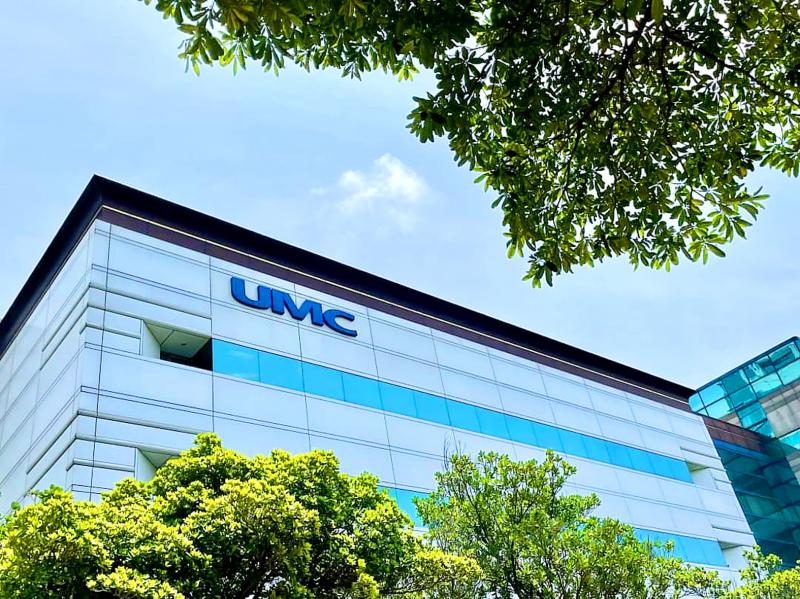United Microelectronics Corp (UMC, 聯電) yesterday reported record net profit for last quarter, saying that it expects revenue to remain little changed this quarter, as robust demand for chips used in vehicles, servers and industrial devices would help offset weakness in smartphones, TVs and PCs.
Overall factory utilization including 8-inch fabs would be at full capacity this quarter and stay at a healthy level next quarter, the world’s third-largest foundry service provider said.
Wafer prices would remain “firm” through the second half of this year, following seven straight quarters of price increases, UMC said.

Photo: Grace Hung, Taipei Times
The company is confident that it will reach its revenue growth target this year, as it aims to grow its revenue at least on par with the foundry industry’s annual revenue growth rate of more than 20 percent, UMC president Jason Wang (王石) told investors during a conference call yesterday.
“While we observe soft demand in smartphones, notebook computers and consumer electronics, other segments such as networking, industrial and automotive have stable demand,” Wang said.
UMC said customers have become “conservative in general” and inventory levels are relatively high in certain segments.
Wang said that the semiconductor industry is undergoing an inventory correction-driven downturn following two years of upcycles.
To digest excessive inventory, a minimal number of customers faced penalty payments as they failed to fully honor their long-term supply agreements with UMC, Wang said.
However, the number of such agreements is still on the rise for UMC’s new capacity in Singapore, he said.
The chipmaker has no plans to cut its capital expenditure because of the short-term industry headwinds, Wang said.
UMC is planning to spend US$3.6 billion on new facilities and equipment this year.
The spending would mostly be used to fund the construction of a new manufacturing facility in Tainan, dubbed P6, in preparation for the start of mass production in June next year.
The facility would add about 5 percent to UMC’s capacity next year, it said.
Deploying 14-nanometer capacity would not be less of a priority for UMC, Wang said.
UMC’s 22-nanometer and 28-nanometer technologies are the most advanced that the company offers, accounting for 22 percent of its total revenue last quarter.
For this quarter, UMC expects wafer shipments to be flat from last quarter.
Gross margin would drop to about 45 percent this quarter from 46.5 percent last quarter, it said.
Net profit last quarter soared 78.6 percent year-on-year to NT$21.33 billion (US$712.6 million) from NT$11.94 billion in the same period last year, benefiting from strong demand across all end markets.
On a quarterly basis, net profit increased 7.7 percent from NT$19.81 billion.
Earnings per share rose to NT$1.74 last quarter, from NT$0.98 a year earlier and NT$1.61 in the previous quarter.

With this year’s Semicon Taiwan trade show set to kick off on Wednesday, market attention has turned to the mass production of advanced packaging technologies and capacity expansion in Taiwan and the US. With traditional scaling reaching physical limits, heterogeneous integration and packaging technologies have emerged as key solutions. Surging demand for artificial intelligence (AI), high-performance computing (HPC) and high-bandwidth memory (HBM) chips has put technologies such as chip-on-wafer-on-substrate (CoWoS), integrated fan-out (InFO), system on integrated chips (SoIC), 3D IC and fan-out panel-level packaging (FOPLP) at the center of semiconductor innovation, making them a major focus at this year’s trade show, according

DEBUT: The trade show is to feature 17 national pavilions, a new high for the event, including from Canada, Costa Rica, Lithuania, Sweden and Vietnam for the first time The Semicon Taiwan trade show, which opens on Wednesday, is expected to see a new high in the number of exhibitors and visitors from around the world, said its organizer, SEMI, which has described the annual event as the “Olympics of the semiconductor industry.” SEMI, which represents companies in the electronics manufacturing and design supply chain, and touts the annual exhibition as the most influential semiconductor trade show in the world, said more than 1,200 enterprises from 56 countries are to showcase their innovations across more than 4,100 booths, and that the event could attract 100,000 visitors. This year’s event features 17

EXPORT GROWTH: The AI boom has shortened chip cycles to just one year, putting pressure on chipmakers to accelerate development and expand packaging capacity Developing a localized supply chain for advanced packaging equipment is critical for keeping pace with customers’ increasingly shrinking time-to-market cycles for new artificial intelligence (AI) chips, Taiwan Semiconductor Manufacturing Co (TSMC, 台積電) said yesterday. Spurred on by the AI revolution, customers are accelerating product upgrades to nearly every year, compared with the two to three-year development cadence in the past, TSMC vice president of advanced packaging technology and service Jun He (何軍) said at a 3D IC Global Summit organized by SEMI in Taipei. These shortened cycles put heavy pressure on chipmakers, as the entire process — from chip design to mass

SEMICONDUCTOR SERVICES: A company executive said that Taiwanese firms must think about how to participate in global supply chains and lift their competitiveness Taiwan Semiconductor Manufacturing Co (TSMC, 台積電) yesterday said it expects to launch its first multifunctional service center in Pingtung County in the middle of 2027, in a bid to foster a resilient high-tech facility construction ecosystem. TSMC broached the idea of creating a center two or three years ago when it started building new manufacturing capacity in the US and Japan, the company said. The center, dubbed an “ecosystem park,” would assist local manufacturing facility construction partners to upgrade their capabilities and secure more deals from other global chipmakers such as Intel Corp, Micron Technology Inc and Infineon Technologies AG, TSMC said. It